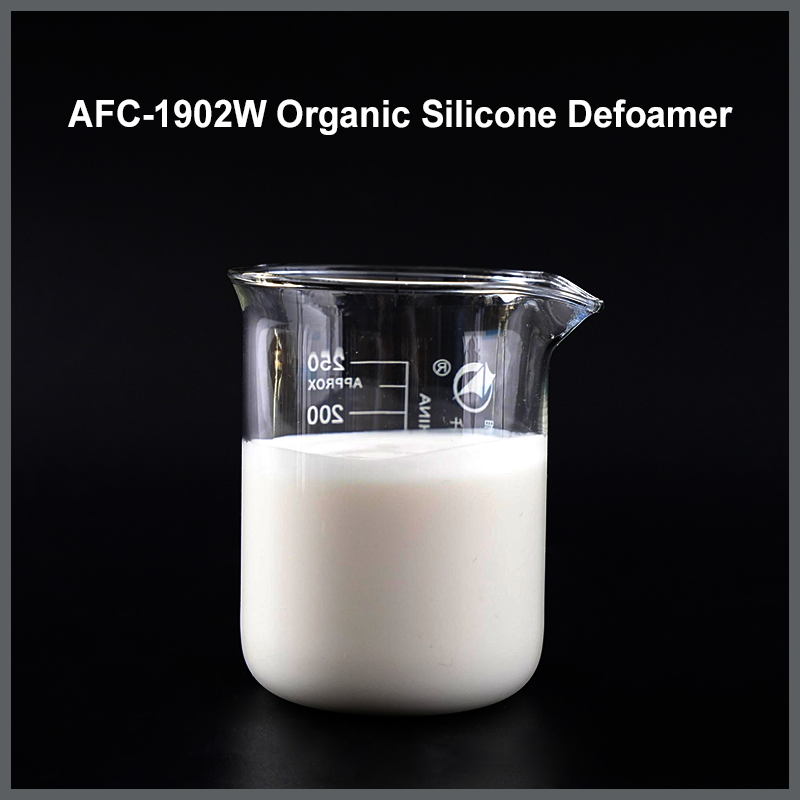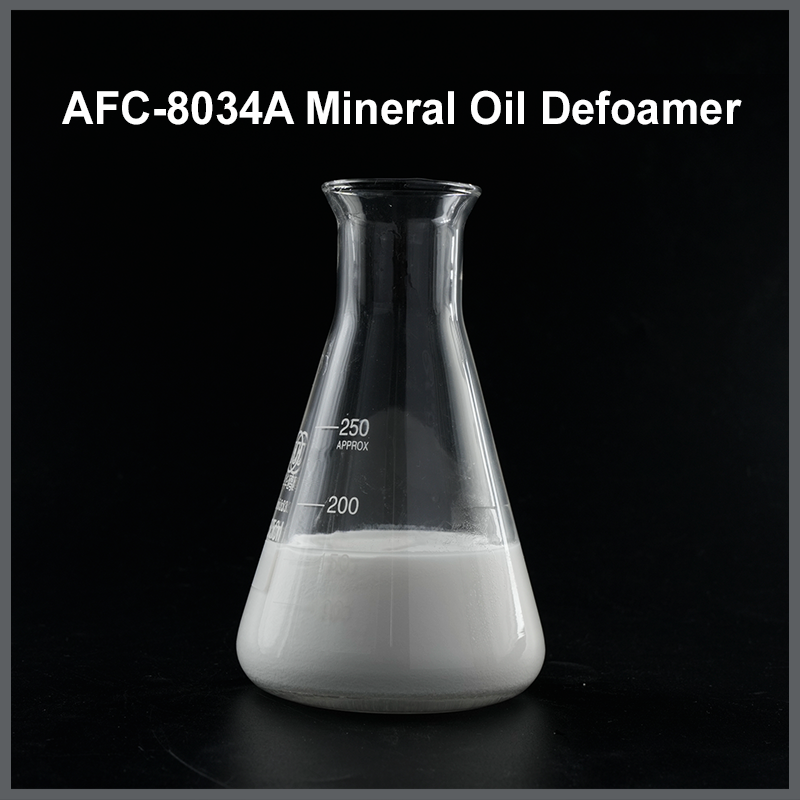products
AFC-1902W Organic Silicone Defoamer
Are you still struggling with stubborn microbubbles and pinholes during your painting process? They not only affect aesthetics but also slow down application efficiency. AFC-1902W, an emulsion-based defoamer specifically designed for all types of water-based coatings, effectively eliminates microbubbles, offers strong compatibility, and easily integrates into any system without causing surface defects.
It's suitable for wood coatings, industrial coatings, architectural coatings, and printing inks. It's effective for both brush and spray applications, and effectively defoams even in medium- and high-viscosity environments. Choose AFC-1902W to save time, effort, and money, and deliver a more flawless painted surface to your customers!

◼PRODUCT DESCRIPTION
AFC-1902W is an emulsion defoamer, especially suitable for eliminating microfoam generated by coatings and paints during the construction process. This product has strong versatility. It can be used in water-based wood and furniture coatings, industrial coatings, architectural coatings and printing inks. It is suitable for airless and mixed air spraying, brushing and roller coating, and is also suitable for medium and high viscosity bubble-free construction.
◼FEATURES
Strong ability to eliminate tiny bubbles.
Strong versatility.
Good compatibility, easy to mix.
◼APPLICATION AREA
Water-based system, architectural paint, wood paint, container paint.


◼Why do building materials need defoamers?
The "Invisible Dangers" of Foam in Building Materials: Comprehensive Impacts from Performance to Appearance
Foam is essentially a dispersed system of gas encapsulated by a thin liquid or solid film. Unremoved foam in building materials can cause a series of problems:
1. Reduced Material Mechanical Properties
Foam creates numerous pores within the material, disrupting structural continuity. For example:
Excessive bubbles in concrete can reduce internal density, significantly reducing compressive and flexural strengths, while also weakening its impermeability and durability (moisture and corrosive media can easily penetrate through the pores).
Residual bubbles in polymer mortar or putty can reduce the bond strength of the material, making it more susceptible to hollowing and flake formation later.
2. Damage to Appearance Quality
Surface or shallow foam directly affects the smoothness and finish of materials:
After application, if foam is not eliminated in architectural coatings (such as latex paint and exterior wall paint), pinholes, craters, orange peel patterns, or "fish eyes" can form on the coating surface. These not only affect the appearance but can also reduce the coating's stain and weather resistance due to the porosity.
In self-leveling flooring materials or cement-based decorative mortars, bubbles can cause surface unevenness, increasing post-polishing costs and even affecting functionality.
3. Interference with Construction Process and Efficiency
Foam can impair material flow and leveling, increasing construction difficulty:
During paint spraying, foam can clog the spray gun or cause splashing due to foam collapse, resulting in material waste and a messy construction environment.
Excessive foam during cement mortar mixing can inflate the material volume, making it difficult to control the actual amount used. Furthermore, bubbles can easily block the concrete during pouring, leading to inaccurate vibration.
4. Impact on Chemical Stability and Durability
In certain materials, bubbles can become a potential risk factor:
Bubbles in waterproofing materials (such as polyurethane waterproofing coatings) can create leakage channels, reducing waterproofing effectiveness;
Bubbles in adhesives can reduce the effective bonding area, and the air trapped within the bubbles can accelerate material degradation (e.g., oxidation).

Foam Pain Points in Different Building Materials: Why Targeted Defoaming Is Necessary?
Due to the varying composition, production processes, and application scenarios of different building materials, the sources and hazards of foam vary, which underlies the necessity of defoamers:
1.Concrete and Cement-Based Materials
Sources of Foam: Air entrainment during mixing, trace gases released by cement hydration, and surfactants introduced by additives such as water reducers.
Core Hazards: Excessive bubbles can reduce concrete strength (especially high-strength concrete), increase permeability (making it susceptible to freeze-thaw damage), and affect concrete surface smoothness (e.g., precast components and plain concrete).
Defoaming Requirements: Excess bubbles must be eliminated while maintaining concrete fluidity and without damaging the "beneficial small bubbles" formed by the air-entraining agent (which provide frost resistance).
2.Architectural Coatings and Latex Paints
Sources of Foam: Mixing during emulsion production, pigment dispersion, and high-speed mixing or spraying during application (where large amounts of air are introduced). Core Hazard: Pinholes and shrinkage cavities on the coating surface affect aesthetics; deep bubbles may cause cracking after drying, reducing scrub resistance and weather resistance.
Defoaming Requirements: Dynamic foam during application must be quickly eliminated, while static foam during storage must be suppressed without affecting the coating's gloss, adhesion, and leveling.
3.Adhesives and Sealants
Foam Sources: Agitation during mixing of resin and curing agent, surfactants in water-based adhesives.
Core Hazard: Bubbles reduce bond strength (actual contact area reduction), and bubbles in sealants can cause seal failure (water or gas leakage).
Defoaming Requirements: Bubbles must be completely eliminated before curing to ensure a dense bond without affecting the adhesive's curing speed or bonding performance.
4. Waterproofing Materials and Grouting Materials
Foam Sources: Air entrained during mixing, and gases generated by chemical reactions (such as the foaming reaction of polyurethane waterproofing).
Core Hazard: Bubbles in waterproofing materials can form "channels," leading to waterproofing failure; bubbles in grouting materials can reduce grout density and impair reinforcement effectiveness. Defoaming requirements: Bubbles need to be eliminated efficiently to ensure that there are no pores in the material after solidification. Especially in scenarios such as high-pressure grouting, the defoaming agent needs to be shear-resistant and stable.

The Core Value of Defoamers: A "Precise Solution" to Foam Problems
Defoamers are not simply "additives"; rather, they address the root cause of foam through a scientific mechanism of action. Their core value lies in:
1. Targeted Destruction of Foam Structure
Defoamers rapidly eliminate existing foam and inhibit the formation of new foam by reducing the surface tension of foam, penetrating the bubble membrane, and promoting the loss of liquid within the membrane, thereby preventing the harmful effects of foam at the root.
2. Ensuring Compliance with Material Performance
For example, the appropriate use of defoamers in concrete can improve density and strength, meeting design grade requirements; their use in paint ensures a smooth, even coating that meets decorative and protective standards.
3. Improving Construction Efficiency and Cost-Effectiveness
Reducing rework caused by foam (e.g., re-coating, concrete repairs), reducing material waste (e.g., paint loss due to foam splashing), and shortening construction cycles (e.g., avoiding extended curing times due to bubble problems).
4. Adapting to Green Building Requirements
Modern environmentally friendly defoamers (such as VOC-free and low-toxicity products) not only address foaming issues but also meet green building requirements for environmentally friendly materials, avoiding any additional burden on the environment and human health.


Request a Quote
Related Recommendations






